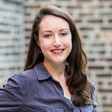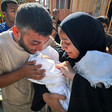Rights and Accountability 28 July 2017

Mourners carry the body of Hussein Abu Hasima, 16, shot dead by Israeli forces, during his funeral in Bureij refugee camp, central Gaza Strip, 28 July.
APA imagesIsraeli forces killed two Palestinians on Friday amid ongoing protests over restrictions at al-Aqsa mosque in Jerusalem.
Hussein Abu Hasima, 16, became the sixth Palestinian to be killed during protests since the closure of al-Aqsa following a deadly shooting attack on police stationed outside it on 14 July.
Abu Hasima was shot by a soldier in the central Gaza Strip as youth confronted occupation forces along the boundary with Israel.
An Israeli army spokesperson claimed that its forces had fired at Palestinians who were burning tires, throwing stones towards soldiers and damaging the boundary fence.
Israeli forces are typically separated from Palestinians inside Gaza by fences and a large distance and are often in fortified positions, making it unlikely that protesting Palestinians could present a credible danger.
Seven others were reportedly injured by live fire during protests in Gaza on Friday.
Abu Hasima is the sixth Palestinian in Gaza to be killed by Israeli fire so far this year, and the 14th child killed in the West Bank and Gaza Strip.
Photos of Abu Hasima circulated on social media after his death:
Palestinian killed in West Bank
Another Palestinian, 24-year-old Abdullah Ali Mahmoud Taqatqa, was slain by Israeli forces in the occupied West Bank earlier in the day.
The Israeli military claimed that Taqatqa was attempting a stabbing attack at the Gush Etzion junction when he was shot and killed.
However, an eyewitness told the Ma’an News Agency, a Palestinian outlet, that Taqatqa was walking towards Bethlehem and soldiers shot at him when he was around 20 meters away from them.
The witness said “one of the soldiers approached the martyr and turned him over with his foot and shot him more than five times, I swear that he didn’t have any type of knife with him or any kind of weapon.”
The Palestine Red Crescent Society told media that soldiers prevented its paramedics from accessing Taqatqa.
No Israelis were reported injured during the incident.
Taqatqa is the third Palestinian to be killed at the junction so far this year. The junction is the gate to one of Israel’s largest settlement blocs and the site of frequent deadly encounters between Palestinians and the heavily armed soldiers guarding the settlements.
Israel alleges that the two other Palestinians shot and fatally wounded at the site this year, one of them a 15-year-old girl named Fatima Taqatqa, were attempting car ramming attacks when soldiers fired at them.
Both Abdallah Taqatqa and Fatima Taqatqa are from the nearby village of Beit Fajjar.
Undated photos said to show Abdallah Taqatqa being detained by Israeli forces during a protest in Bethlehem circulated on social media after his death:
Scores of alleged Palestinian assailants have been shot dead by Israeli forces in recent years when they posed no immediate danger to life. Amnesty International has called for several such incidents to be investigated as possible extrajudicial executions.Also on Friday, a Palestinian was critically injured when he was shot by Israeli forces during a protest over restrictions at al-Aqsa in the town of al-Ram, north of Jerusalem.
A Palestinian who was shot in the head by soldiers during an al-Aqsa protest in the nearby village of Hizma on Monday died of his injuries on Thursday. Thousands of mourners buried Muhammad Fathi Kanaan, 25, in Hizma on Friday.
Fifty-four Palestinians have been killed by Israeli fire so far this year. Fourteen Israelis, most of them soldiers, and a British national have been killed by Palestinians during the same period.
Al-Aqsa
The gates to al-Aqsa were opened to all Palestinian worshippers able to access the holy site on Friday afternoon:
Israel had barred men under the age of 50 from entering for noon prayer: Those who had been barred observed noon prayer in the streets of Jerusalem: Israel’s regime of closure, military checkpoints and other forms of movement restrictions prevents most Palestinians in the occupied West Bank and Gaza Strip from worshipping at al-Aqsa unless they get special permits from Israel.An Israeli police spokesperson told media that the age restriction pertained to noon prayers only on Friday.
Huge crowds were anticipated for noon prayers at al-Aqsa after Palestinians worshipped there for the first time in nearly two weeks on Thursday afternoon.
Worshippers had refused to enter the al-Aqsa compound after Israel unilaterally installed security cameras and metal detectors at its gates following the deadly ambush on police stationed outside the site two weeks ago. The last of the installations was removed overnight Wednesday after mass Palestinian protest and international pressure.
An hour after the last gate to al-Aqsa was unlocked on Thursday, Israeli forces fired stun grenades at the thousands of worshippers who had gathered:
Around 100 Palestinians were injured Thursday as Israeli forces beat worshippers and fired tear gas and rubber-coated steel bullets.Magdalena Mughrabi, Amnesty International’s deputy director for the Middle East and North Africa, stated that the Israeli assault “appeared to be an entirely unprovoked attack.”
“The Israeli authorities must urgently rein in their security forces to prevent the situation from spiraling out of control and to avoid further bloodshed,” Mughrabi added.
Approximately 100 Palestinians were detained during confrontations between police and worshippers on Thursday. They were reportedly banned from al-Aqsa for two weeks and subjected to other restrictions on their movement in Jerusalem.
Another 21 Palestinians were banned from al-Aqsa for 15 days, the Palestinian Prisoners Society stated on Friday.





